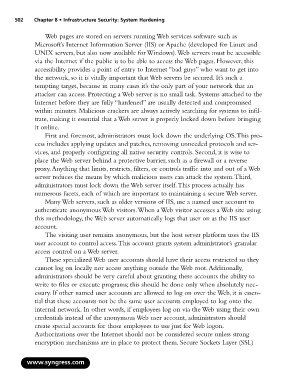Page 518 - StudyBook.pdf
P. 518
502 Chapter 8 • Infrastructure Security: System Hardening
Web pages are stored on servers running Web services software such as
Microsoft’s Internet Information Server (IIS) or Apache (developed for Linux and
UNIX servers, but also now available for Windows).Web servers must be accessible
via the Internet if the public is to be able to access the Web pages. However, this
accessibility provides a point of entry to Internet “bad guys” who want to get into
the network, so it is vitally important that Web servers be secured. It’s such a
tempting target, because in many cases it’s the only part of your network that an
attacker can access. Protecting a Web server is no small task. Systems attached to the
Internet before they are fully “hardened” are usually detected and compromised
within minutes. Malicious crackers are always actively searching for systems to infil-
trate, making it essential that a Web server is properly locked down before bringing
it online.
First and foremost, administrators must lock down the underlying OS.This pro-
cess includes applying updates and patches, removing unneeded protocols and ser-
vices, and properly configuring all native security controls. Second, it is wise to
place the Web server behind a protective barrier, such as a firewall or a reverse
proxy.Anything that limits, restricts, filters, or controls traffic into and out of a Web
server reduces the means by which malicious users can attack the system.Third,
administrators must lock down the Web server itself.This process actually has
numerous facets, each of which are important to maintaining a secure Web server.
Many Web servers, such as older versions of IIS, use a named user account to
authenticate anonymous Web visitors.When a Web visitor accesses a Web site using
this methodology, the Web server automatically logs that user on as the IIS user
account.
The visiting user remains anonymous, but the host server platform uses the IIS
user account to control access.This account grants system administrator’s granular
access control on a Web server.
These specialized Web user accounts should have their access restricted so they
cannot log on locally nor access anything outside the Web root.Additionally,
administrators should be very careful about granting these accounts the ability to
write to files or execute programs; this should be done only when absolutely nec-
essary. If other named user accounts are allowed to log on over the Web, it is essen-
tial that these accounts not be the same user accounts employed to log onto the
internal network. In other words, if employees log on via the Web using their own
credentials instead of the anonymous Web user account, administrators should
create special accounts for those employees to use just for Web logon.
Authorizations over the Internet should not be considered secure unless strong
encryption mechanisms are in place to protect them. Secure Sockets Layer (SSL)
www.syngress.com

